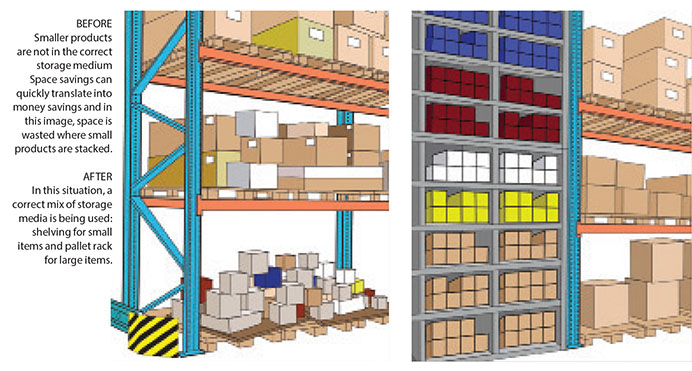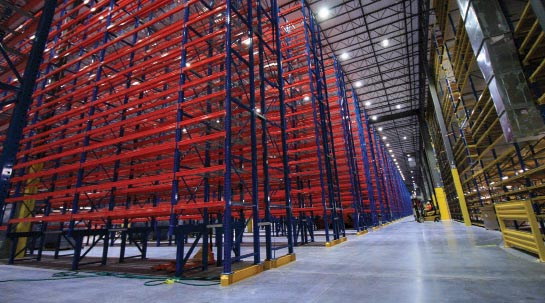Rack and Shelving: Engineering for e-commerce
The growth in e-commerce is driving changes in the rack and shelving world as engineers get more involved and traditional designs become popular again.
A mainstay in warehouses and DCs around the globe, rack and shelving is one equipment sector that’s stayed on the sidelines during the technological revolution. But that doesn’t mean forces like e-commerce and omni-channel distribution haven’t impacted the rack and shelving world, where meeting customers’ rapid-order fulfillment needs has become a focal point for the makers of these critical support systems.
“We’re seeing a lot more manufacturers and retailers updating their DCs and incorporating new technologies, automation and pick modules that support rapid-order fulfillment,” says Dave Olson, national sales and marketing manager for Ridg-U-Rak. “Consumers have grown accustomed to receiving orders in two or three days, and that’s pushing companies to change their order fulfillment processes.”
As part of that charge, Olson says companies are looking carefully at the rack and shelving that supports those operations. The selective static storage racks that have a place in most modern-day DCs are giving way to more multi-level picking operations that can accommodate faster picking and picking of multi-item orders (versus just palletized goods).
“Instead of just sending very narrow aisle orderpickers out to fill boxes or fulfill orders,” says Olson, “companies are using picking modules that send [items] down to sortation equipment that’s automating and streamlining the entire operation.”

Olson says the proliferation of automated storage and retrieval systems (AS/RS) is impacting how rack and shelving manufacturers design their solutions. Where there is still a place for traditional, selective pallet racking, for example, he says many large-scale DC projects are making more room for a larger number of smaller products or SKUs. To accommodate these needs, he says Ridg-U-Rak is putting more time into the actual engineering process.
“Most of the systems going into today’s DCs aren’t cookie cutter; they’re very customer specific,” says Olson. “While the components themselves may be similar from one operation to the next, there are distinct variations in height, depth, length and so forth. This requires much more engineering design involvement because it’s not like you can go and just say, “Oh, this customer wants to a buy a pick module, so let’s go get it off the shelf and send it to them.”
Olson says the manufacturer is also looking more carefully at seismic design (i.e., the calculation of the response of a structure to earthquakes), with the understanding that most states—not just California—now have some level of seismic standards. “There’s really no such thing as ‘non-seismic’ anymore,” he says, “so pretty much everything we engineer has to factor in some level of seismic design.”
Rip and replace
Business is brisk at Steel King Industries, which is being called upon to come up with rack and shelving designs that support today’s e-commerce-enabled warehouses and DCs. “E-commerce has really driven a lot of the business for rack manufacturers over the last couple of years,” says Donald Heemstra, director of marketing. Like Olson, he says the shift from storing and shipping full pallet loads to stores to picking and packing individual orders for fast shipping has made companies rethink their storage configurations.
“With short delivery time periods as a driving force, companies are building dedicated e-commerce facilities, retrofitting existing facilities, and replacing standard pallet racks that would hold 2,500 pounds of toasters, for example, with racking that’s better suited for holding ‘broken boxes’ or ‘broken cases,’” Heemstra explains. “That way, an operator can pick one and two items, put the items in a tub, and then send it down to the packing area.”
To meet these needs, companies like Steel King are producing more pick modules that allow dense storage of products, reduced materials handling, and the ability to fill multiple SKU customer shipments in a timely manner. And, when designed as a multi-level rack supported system, these pick modules also enhance space utilization—yet another “must have” in an era where floor space comes at a premium. Heemstra says the pick modules can be multi-level systems ranging in height from two to four levels, and are generally used to store up to tens of thousands of different SKUs.
“Depending on the company’s operations, workers either go up and down the aisles using pick-to-light technology that tells them when to stop and pick an item,” Heemstra says, “or they might use a handheld or GPS-type system.” Regardless of the infrastructure, he says workers use the pick modules to grab the items, put them in a box (or on a conveyor that runs through the pick module) and fill the order quickly.
“From a structure standpoint, the system still comprises pallet rack frames and pallet rack beams,” Heemstra says, “but the pick module holds small cases/boxes and can handle thousands of different SKUs. That’s the difference.”
Increased collaboration
The fact that today’s rack and shelving components have to be able to integrate with robots, AS/RS, carts, conveyors and other tech-oriented equipment has pushed manufacturers into a completely different realm: that of engineer, versus just product maker.
A company that needs its shelving and racks to integrate with a new conveyor system, for example, will generally work with an integrator to ensure the smoothest possible process. This can present challenges for companies like Steel King, which has to understand exactly where the conveyor is going, how it will be positioned, what it will be moving, and how the goods will flow across it. “We have to factor all of that into the rack design,” says Heemstra, “where even just one subtle change on the integrator’s part can have major repercussions on our design process.”
To avoid pitfalls in this area, Heemstra says the manufacturer spends more time on project management—from the initial quote all the way through the design phase and right into the actual equipment manufacturing process. “It takes a lot of teamwork,” he says. “We all have to be able to work together to meet the customers’ demands, but in some cases, we’re still the low man on the totem pole in that chain. That doesn’t make it any easier.”
What’s old is new again
Over the last 18 months, Heemstra has seen an interesting trend in the rack and shelving space, where companies seem to have a renewed interest in drive-in racking. Traditionally used by the cold storage sector (i.e., beverage and ice cream manufacturers and distributors), drive-in racking has been “around forever,” according to Heemstra, but is having a sort of rebirth as companies attempt to pack as much as they can into small spaces.

“At one point a few years ago, it seemed like interest in this product was fading as customers moved to more dynamic solutions like pallet-flow or push-back,” says Heemstra. “Over the last year and a half, our drive-in racks [sales] just blew the numbers out of the water in a way that we haven’t seen in years.”
And while Heemstra couldn’t pinpoint a specific reason for this renewed interest, he says the fact that the refrigerated/frozen food industries are doing well—while at the same time beverage companies are continually innovating and coming up with new products—could have something to do with it.
“Additionally, companies realize that from a cost standpoint, compared to some other types of pallet racking and high-density solutions,” Heemstra says, “that drive-in racking is relatively inexpensive and, as such, produces a faster return on investment.”
New twist on an existing design
Tom Rogers, president and CEO at Western Pacific Storage Solutions, understands that innovating in the rack and shelving industry isn’t always easy. In fact, he says that in the 20+ years that he’s been attending the ProMat show, the number of related innovations worth noting have been minimal.
“I basically see the same thing over and over again,” says Rogers, “but last time around, I started to see more technology being introduced and used in our industry.” In fact, he was approached by numerous engineering firms offering software that would help Western Pacific “design faster and quote faster,” Rogers says. “I see that happening in the future, but at this point shelving is still shelving, to be honest.”
To break that mold, Rogers says his company recently introduced the Accu-Wall shelving system, which integrates with put-to-light and pick-to-light systems and helps speed up the omni-channel distribution process. Traditionally known as pass-through shelving, this product is backless and allows products to be loaded from the rear and then picked or put from the front. “It’s for fast-moving, small items,” says Rogers, “and was designed to support the whole e-commerce movement.”
Looking ahead, Rogers expects basic rack and shelving construction to remain fairly constant, but says more of those products will be customized and engineered to meet the needs of specific customers. “We try to stay away from the commodity concept because we don’t want people to think we’re just a steel-bender,” Rogers says. “Customers are asking for more engineered solutions, and the interplay among manufacturer, dealer and end user continues to expand. Basically, the more value we add, the more the customer wants.”













